Thinking of starting an online business but not sure where to sell: Shopify vs Amazon? Both of these platforms are two of the biggest names in eCommerce, each offering unique advantages. Shopify lets you build your own store, while Amazon provides a golden door to millions of shoppers. So, the big question is: which one is better for selling your products online?
The key is understanding how each platform works. In the following section, LitCommerce will break down the key differences between Shopify and Amazon to help you find the best choice for your business:
- Selling fees
- Store setup
- eCommerce ecosystem
- Store design and customization
- Shipping and fulfillment
- Payment methods
- Marketing features
- Integrations and add-ons
Is Shopify better than Amazon? Or vice versa? Let’s dive in to make the best decision when choosing Shopify or Amazon!
Shopify vs Amazon: Pros & Cons
In general, both Amazon and Shopify are platforms that allow you to build your store and sell products online, but they serve different purposes.
The key difference between Shopify and Amazon is that Shopify is an eCommerce platform while Amazon is an online marketplace. With Shopify, you design, create, and manage a standalone online store using its tools. Meanwhile, with Amazon, you list your products alongside those of other sellers on an existing marketplace.
Amazon is one of the top platforms allowing you to instantly reach millions of shoppers with existing demand, whereas Shopify gives you full control over your store’s branding and customer experience.
So, which one is the better choice for your business? Amazon or Shopify? Let’s find out by comparing the pros and cons of selling on each platform.
Pros and cons of selling on Shopify
So, is Shopify better than Amazon? Let’s first look at the pros and cons of creating an online store on Shopify in this Shopify vs Amazon comparison.
Pros of selling on Shopify
Shopify is a powerful eCommerce platform that allows you to create, manage, and grow your own online store. Here are some of the biggest advantages of selling on Shopify over Amazon.
- Full control over your brand and store: Shopify allows you to design a unique storefront that represents your brand. You can choose from numerous customizable Shopify themes and even modify them to fit your business identity.
- Easy store setup with user-friendly tools: Shopify’s drag-and-drop builder makes it simple to set up a store without coding knowledge. Plus, it offers mobile-responsive themes, ensuring a great shopping experience across different devices.
- Access to powerful eCommerce tools: Shopify provides essential tools for managing your store, such as abandoned cart recovery, inventory management, or invoice generation.
- Multiple payment options: Unlike Amazon, Shopify supports a variety of payment methods, including Shopify Payments, PayPal, Amazon Pay, and credit/debit cards. You can provide customers with flexible checkout options.
- No direct competition on your store: Since you own your store, you’re not competing with other sellers or with Shopify itself. This helps you maintain a stable pricing strategy without pressure from competitors.
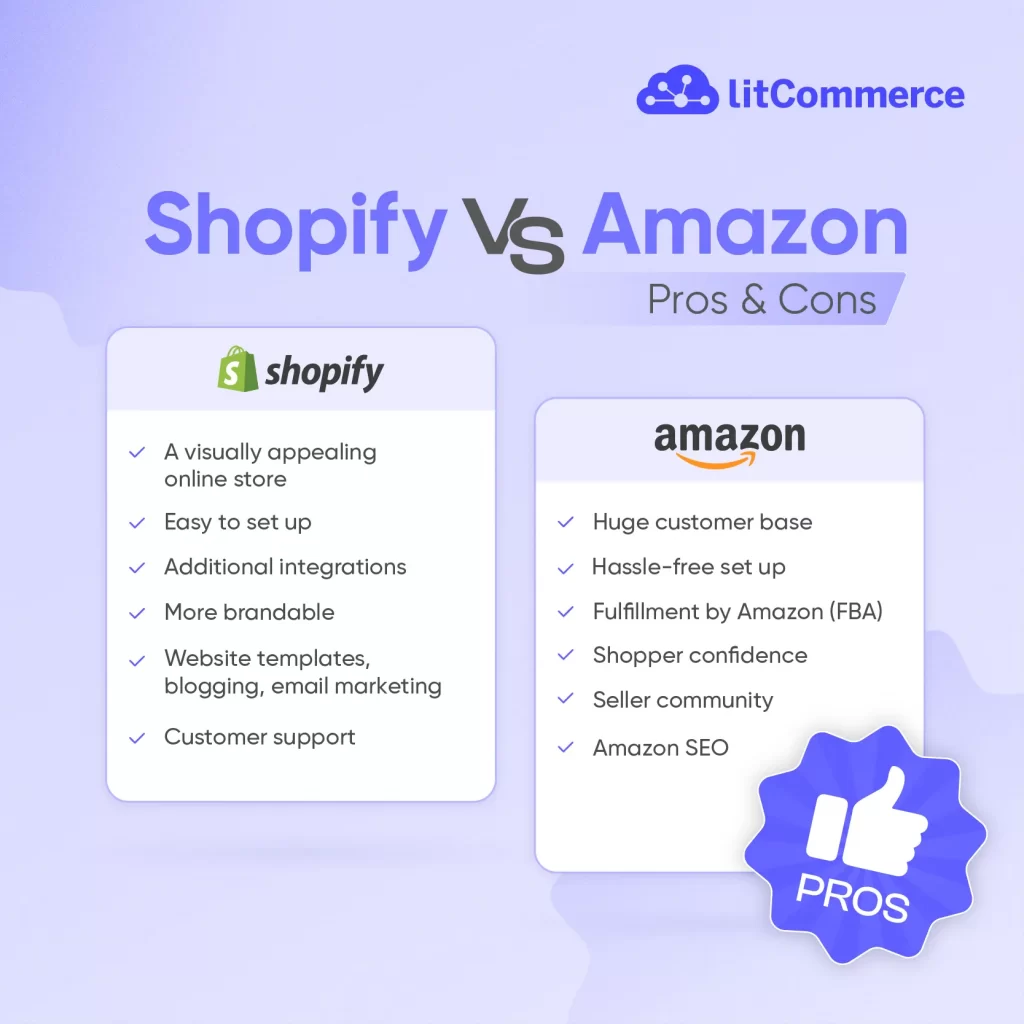
Cons of selling on Shopify
Despite its benefits, Shopify also has some drawbacks that you should consider when comparing Amazon vs Shopify.
- Requires marketing to drive traffic: Unlike Amazon, Shopify doesn’t have built-in traffic. You’ll need to invest in SEO, social media marketing, paid ads, or influencer collaborations to attract visitors.
- Additional costs for third-party apps: While Shopify offers basic features, many advanced functionalities (such as email automation, upselling tools, or premium themes) require paid third-party apps, adding to your costs.
- Building trust takes time: With Amazon, customers already trust the platform, but on Shopify, you must establish credibility from scratch. Gathering reviews and earning trust can take time.
Pros and cons of selling on Amazon
Comparing Amazon vs Shopify, let’s continue with the pros and cons of starting to sell with Amazon.
Pros of selling on Amazon
There is no doubt: Amazon is the biggest marketplace in the world with hundreds of active users. So, here are some reasons why selling on Amazon can be beneficial:
- Instant access to millions of shoppers: Amazon receives over 236 million visitors each month in the U.S. alone. Opening a store on Amazon means you get the chance to reach this huge number of shoppers who are likely actively searching for products.
- Simple store setup: Amazon makes it easy to start selling. You can create a seller account, list your products, and begin selling without designing a website.
- Amazon FBA: With Fulfillment by Amazon (FBA), you can send your inventory to Amazon’s fulfillment centers. Amazon handles storage, packaging, shipping, and even customer service, simplifying fullfilment and making selling more convenient.
- Leverage Amazon’s reputation: Many shoppers trust Amazon and feel secure purchasing from its marketplace. By selling on Amazon, you can benefit from this trust and increase your sales potential.
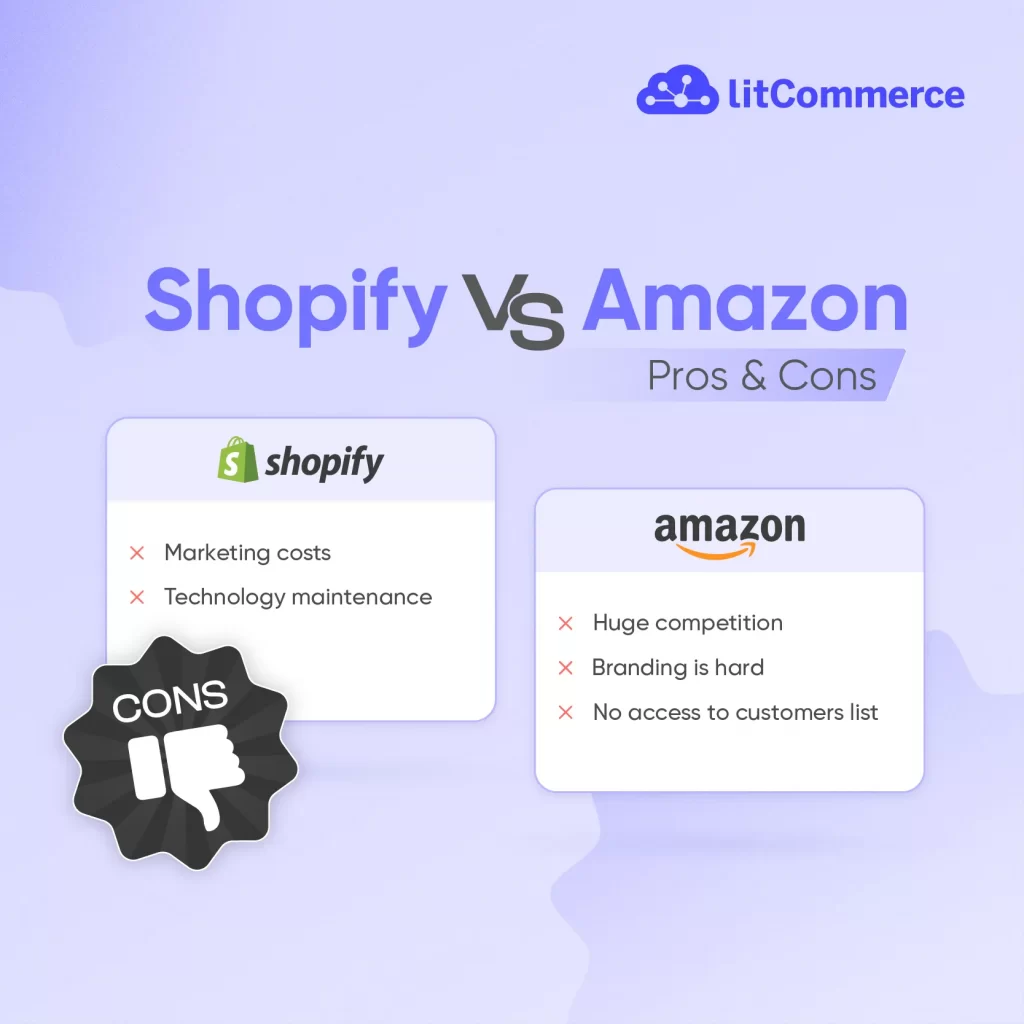
Cons of selling on Amazon
While Amazon is great for exposure, there are some downsides to selling on the platform:
- High competition from other sellers (and Amazon itself!): Amazon is highly competitive, with over a million small to mid-sized businesses selling on the platform. Additionally, you may find yourself competing directly with Amazon’s own products.
- Applying for ASINs, GTINs, and Brand Registry can be complex: Amazon has strict listing policies. If your product already exists on Amazon, you can apply to sell with an existing ASIN. If not, you will need to create a new listing with a GTIN (UPC, EAN, ISBN) or apply for an exemption.
- Multiple fees reduce profit margins: Amazon sellers must pay several fees, including subscription fees, referral fees, and probable FBA fees.
- Limited branding and customer data: Amazon owns the customer relationship, meaning you can’t directly market to buyers or collect detailed customer data. This makes it harder to build long-term brand loyalty.
- Restricted payment options: Unlike Shopify, Amazon has limited payment options, primarily Amazon Pay and credit/debit cards. Customers who prefer PayPal or other payment methods won’t have flexibility.
So, is it better to sell on Shopify or Amazon?
Choose Shopify if you want full control over your brand, customizable store design, and the ability to scale your business independently. Otherwise, choose Amazon if you want quick access to a huge customer base and prefer a streamlined fulfillment process without managing logistics.
Shopify vs Amazon: 8 Key Aspects Comparison
Now that you’ve got the general differences between Amazon and Shopify. Ready to learn more details about each channel? We’ll get you started now!
1. Selling costs
The main aim of selling on Shopify vs Amazon is to make more money than you put in. It’s not logical to choose a platform that’s expensive if you’re only selling a few handmade items monthly.
Shopify vs Amazon have distinct pricing structures, but with a smart plan, you can still make a profit. Keep reading to learn about their pricing and fees.
Shopify fees

Shopify has three price plans:
- The Basic plan: $25 per month (Best for solo entrepreneurs)
- The Shopify plan: $65 per month (Best for small businesses)
- The Advanced plan: $399 per month (Best for businesses of all sizes)
- The Plus plan: $2300 per month (Best for complex business models)
Compared to Shopify competitors, this platform is sometimes seen as pricey, but in our opinion, you get good sales features for what you pay. If you’re concerned about the cost, Shopify offers a 3-day free trial followed by 3 months at $1 per month. This gives you a chance to test the platform and maybe start selling before committing to the main plans. As you move up through the pricing plans, you unlock more features.
Unlike some platforms, Shopify doesn’t charge referral fees, but it does have other types of fees for each payment. These are transaction fees ranging from 0.6% to 2%, depending on the payment method and plan you’re on. The Basic plan charges the highest rate at 2% and the lowest from the Plus plan.
For credit card payments, there are fees for all payment gateways, including Shopify Payments. The regular credit card rate on Shopify is 2.9% + 30¢. As you upgrade through Shopify’s price plans, your online credit card rates decrease to 2.4% + 30¢.
Note: Your total cost for selling with Shopify may change a lot if you use third-party apps on the platform. Such apps are to enhance your store’s functionality, and they do come with some pricing tiers. Should you rely heavily on apps, the final charges each month will add up quite a lot. Otherwise, if you have some expertise in coding and don’t need to install apps, the total cost for selling with Shopify can be extremely affordable.
Amazon fees
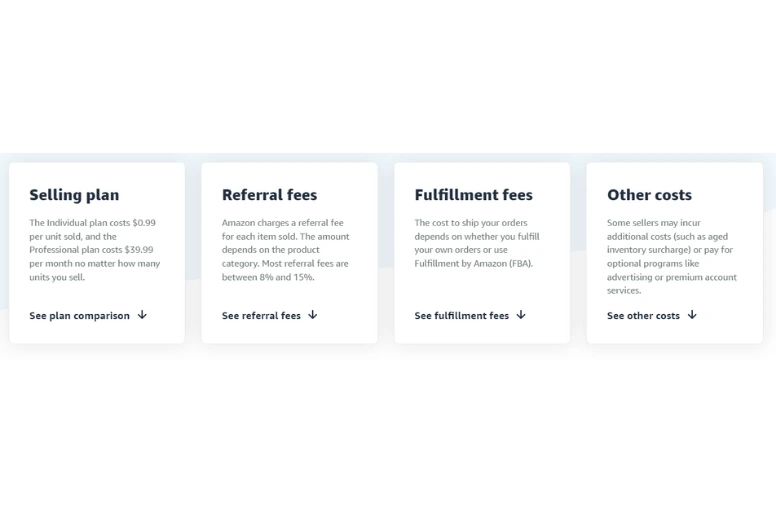
Amazon has two selling plans:
- The Professional Selling plan: $39.99/ month, and you also have to pay additional selling fees (which depend on the type of products you’re selling).
- The Individual Selling plan: doesn’t charge a monthly fee; instead, you pay $0.99 for each item you sell. The Individual plan is suitable for anyone planning to sell less than 40 items per month. Because of this, it has fewer features available. For example, you can’t customize shipping rates on the Individual plan.
The marketplace charges selling fees in addition to its monthly subscription. These fees differ based on the product category and include referral fees and shipping fees. The referral fees have a minimum of $0.30 and generally range between 8% to 15% of the total sale. However, certain categories, like Device Accessories, have a high referral fee of 45%, meaning you could lose almost half of your sales to Amazon.
If you opt for FBA (Fulfillment by Amazon), there are various fees, ranging from $2.41 to $137.32 for fulfillment per unit. Additionally, there are monthly inventory storage fees, ranging from $0.69 to $2.40 per cubic foot. These costs depend on factors such as the size, volume, type of product, and even the time of year. You can find more details about these prices on Amazon’s website.
Which is better, Amazon or Shopify in terms of pricing? Shopify wins
Shopify has a simpler pricing structure with fixed monthly fees, whereas Amazon’s fees vary based on the products sold and additional expenses like fulfillment fees. But remember, merchants on Shopify may pay much more if they rely heavily on third-party apps.
2. Store setup
Whatever you sell, the goal is to make your online selling experience as seamless as possible. That’s why the store setup process should also be taken into account when it comes to choosing between Shopify vs Amazon.
Shopify
Setting up your online shop might feel like a big task, but based on our experience with Shopify, it does a great job of simplifying the process. With an easy setup, users can effortlessly create and personalize their online stores by using available templates and themes.
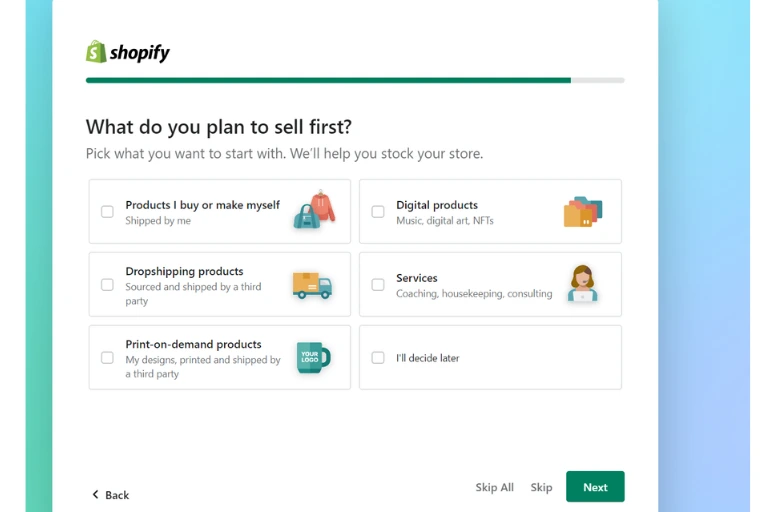
They provide a user-friendly dashboard where you can use the drag-and-drop editor to customize your store easily. You can also handle order fulfillment, inventory, products, and other tasks hassle-free.
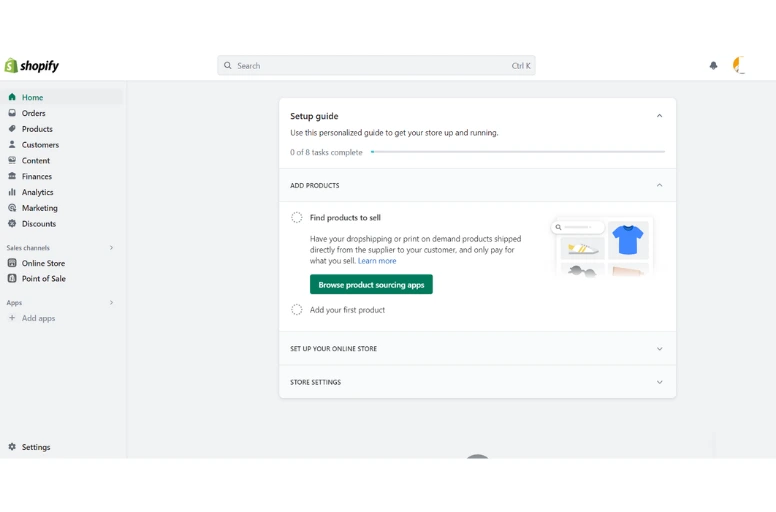
Shopify also provides access to a Shopify Experts Marketplace where you can hire a professional to help with setup, SEO, and other tasks.
Plus, the platform anticipated the impatience in handling tasks and introduced Shopify Magic—an AI text generation tool. Shopify Magic can generate product descriptions in various tones of voice based on a short description, saving you significant time when updating your store’s inventory.
Amazon
Comparing the setup of Shopify vs Amazon store, the setup process on Amazon might be a bit more intricate than Shopify. Even if you just need to fill in your Amazon store information and add product information for your listings, it involves several steps before signing up and demands a significant amount of detailed information.
Amazon requires every product to have an ASIN. If your product already exists on Amazon, you can apply to sell and add it to an existing ASIN. If not, you may need to create a new listing with a GTIN (UPC, EAN, ISBN) or apply for a GTIN exemption, whose the approval process can be time-consuming.
Additionally, their dashboard appears more complicated, containing a lot of information, making it a bit confusing for beginners. Also, the process of uploading images to product listings can be a bit cumbersome initially, but as you become familiar with the function, it becomes easier over time.
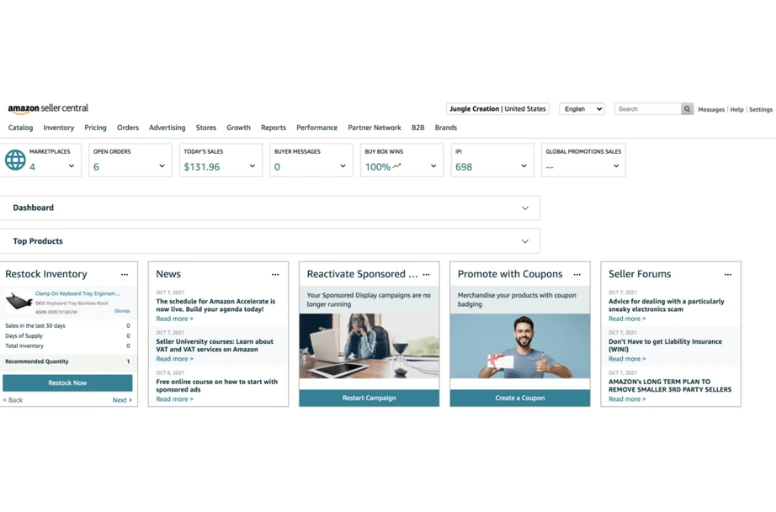
Additionally, there is intense competition on Amazon, so it’s important to make your product listings, prices, and how you deliver them better than others to be noticed.
Building an online store on Shopify vs Amazon?
Setting up a store on Amazon is faster but comes with more restrictions and listing requirements. Shopify takes more time to customize your product page and store.
3. eCommerce ecosystem
When selling on Amazon vs Shopify, it’s crucial to focus on their eCommerce capabilities. This is especially true for the Shopify vs Amazon comparison.
Shopify
This platform provides numerous robust features that are integrated into the service itself:
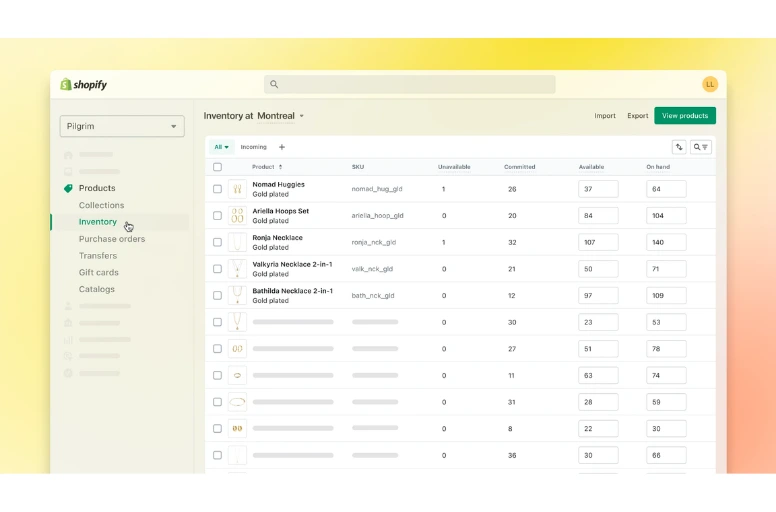
- Managing products: Shopify allows you to easily add new products through the back-end interface or by importing CSV files. The process of filling in product information is user-friendly, and you can also assign categories to your products.
- Abandoned Cart Recovery: All pricing plans on Shopify come with the default feature of abandoned cart recovery. This allows you to identify the reasons why customers didn’t complete their purchases and send follow-up emails to them. Additionally, Shopify offers other helpful tools like automatic tax calculation, a logo maker, and a QR code generator.
- Shipping: Shopify now offers its own shipping software called Shopify Shipping, which is available for free to all store owners. With Shopify Shipping, you can calculate real-time shipping rates, purchase and print shipping labels, and track shipments.
- Analytics: Shopify provides detailed insights into your online store’s performance, customer behavior, and sales trends. You can easily track important metrics such as website traffic, conversion rates, and average order value. Furthermore, advanced analytics tools like sales channel reporting and customer lifetime value analysis are also available.
- Free SSL certificate: Shopify provides all users with such certificates. To be more specific, they’ll contribute to security, which is highly involved when you publish your store or make a transaction.
- In-person selling: The platform offers POS Light, a solution whenever you want to sell at pop-ups or markets. This wouldn’t charge, but if you want a more sufficient solution for greater workflow, Shopify POS Pro can be your ideal one. Yet, this would charge another $89/month.
Amazon
When it comes to eCommerce features, Amazon also allows you to manage your products conveniently.
- Managing products: On Amazon, you can add new products individually using their interactive listing tool. If you have a large number of products to add, Amazon provides editable Inventory File Templates that can be used in Excel.
- Different selling platforms: If you specialize in selling specific types of products, Amazon offers additional platforms tailored to those categories. For example, Amazon KDP is for selling books, and Amazon Handmade is for selling vintage and handmade items.
- Analytics: Amazon provides limited analytics for individual sellers on its marketplace. While sellers can access some data on sales performance, inventory levels, and customer feedback, the range of metrics and insights is not as extensive as what Shopify offers.
- Shipping: Amazon offers two methods for shipping products. Sellers can choose self-fulfillment, where they are responsible for storing, packing, and shipping products to customers. Alternatively, sellers can use Amazon’s Fulfillment by Amazon (FBA) service, which allows them to store products in Amazon’s fulfillment centers. FBA leverages Amazon’s efficient order processing and logistics infrastructure, providing fast delivery options such as Amazon Prime, which can attract more customers.
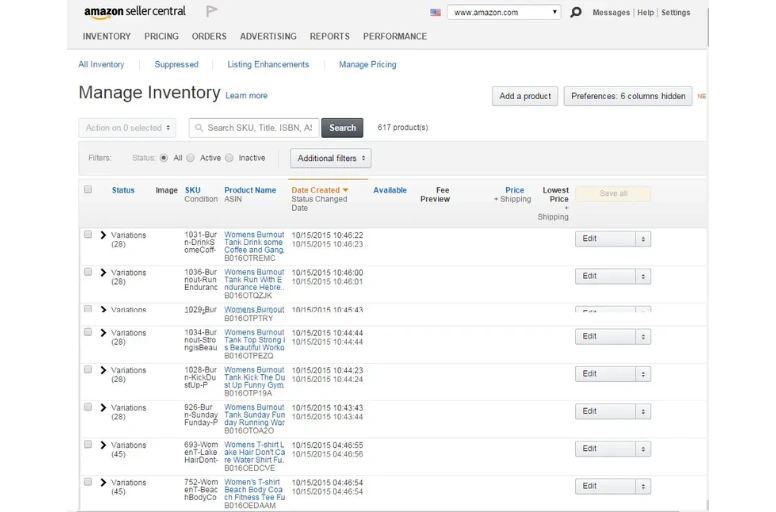
Regarding eCommerce ecosysteme, should you choose Amazon or Shopify? We believe Shopify has won!
Although both sales channels offer powerful features to help you start selling and earning, Shopify has more to provide as an eCommerce platform. In fact, Shopify offers you with more functionality, built-in tools, and multichannel selling capabilities. Compared to Shopify vs Amazon, Amazon seems to get merchants a simpler selling experience with stores.
However, if you speak solely of shipping, Amazon may win due to FBA (Fulfillment by Amazon).
4. Store design and customization
As we’re all aware, making a good first impression is crucial. Impressions matter when customers first see your store. It’s a challenge because there are already thousands of stores out there, and the design of your store is the key to making it stand out.
Now, when it comes to designing tools, which one is better: Shopify vs Amazon?
Shopify

Shopify gives you access to a variety of well-designed templates. Currently, they offer an impressive selection of 200+ templates with 13 free and over 189 premium ones for you to choose from. This ensures that you can create an appealing store.
However, it’s worth noting that the premium templates come at a price, which may go between $89 to $350, and the free ones might look a bit basic. The design features in Shopify are friendly to users and SEO, making it easy for all sellers with even no coding expertise to start with.
But if you want to make more advanced changes in the backend, you might need to collaborate with a developer. This is because Shopify’s templates use Liquid templating code, which can be challenging to access if you’re not familiar with programming.
Amazon
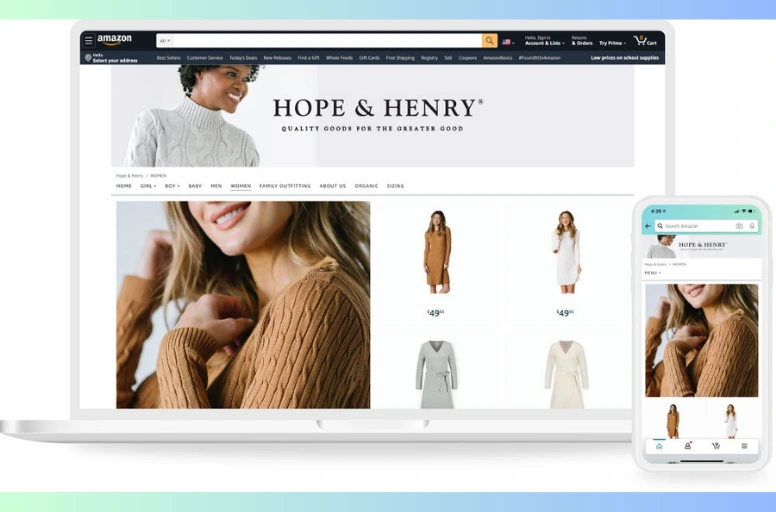
When comparing Amazon store vs Shopify, Amazon has more design limitations compared to Shopify. All pages on Amazon have a similar layout, and there are only three templates available for your product detail page. While you can upload your own images, your store page is meant to be recognized as Amazon’s, not distinctly yours.
Although there are some customizable elements on Amazon, it’s not as flexible as Shopify. Additionally, your products will be displayed alongside those of your competitors. This may be convenient for customers, but it can make it challenging for you to direct their attention specifically to your store.
Which is better, Amazon or Shopify in terms of design flexibility? Shopify wins
Shopify provides more freedom in design compared to Amazon. You can use various themes and make adjustments to colors and font sizes to better suit your preferences and branding.
Leverage the Power of Shopify and Amazon
Why sell on one channel while you can do both on Amazon and Shopify. Check out LitCommerce to integrate your stores together and start streamlining now!
5. Shipping and fulfillment
As promised, we will further discuss shipping and fulfillment on Shopify vs Amazon. Here are some highlights you may want to take note of:
- Shopify offers a full network of shipping and fulfillment but you might have some tasks incoming.
- Amazon saves time and lets you focus more on promoting your products on the marketplace thanks to FBA (Fulfillment by Amazon).
Shopify
Now let’s talk about shipping and fulfillment on Shopify.
For a long while, Shopify has been partnering with major carriers across the globe. Some of the most popular names are:
- USPS (United States): Offers discounted rates on domestic and international services like Priority Mail, First-Class Package, and Media Mail.
- UPS (United States and Canada): Provides domestic and international shipping options like Ground, Air, and Worldwide Express.
- DHL Express (United States): Offers fast international shipping to over 220 countries.
- Canada Post (Canada): Provides domestic and international services like Expedited Parcel, Xpresspost, and International Parcel.
- Sendle (Australia): Shopify’s preferred carrier in Australia, offering up to 44% off shipping rates.
More about shipping and fulfillment on Shopify, the platform tells that it lets merchants choose among multiple carriers with the best shipping rates (discounts are available), print shipping labels easily, and map order routings from multiple locations.
Also, Shopify can help with both international and local pick-ups. Based on those grounds, in any case, you can always ensure a package will reach its final destination.
That’s some highlights about the shipping and fulfillment network of Shopify. Besides its fully established network, Shopify always tries to simplify the shipping and fulfillment procedure for businesses by providing integrated shipping tools. Some of them are Shopify Shipping, ShipStation, and ClickShip.
And if you wonder whether it is cheaper to ship on Shopify? According to its full shipping guidelines, you may get up to 88% discount on shipping with its major carriers. Also, in many cases, Shopify allows its merchants to ship and fulfill at much more affordable rates than those who don’t use Shopify.
Amazon
First, Amazon shipping and fulfillment has two methods: FBA (Fulfillment by Amazon) and FBM (Fulfillment by Merchants).
- Fulfillment by Amazon (FBA) is a service that helps sellers with all the shipping and fulfilling tasks. They must ship their packages to the Amazon FBA center and let the house handle the rest. In 2023, there were already 600,000+ FBA sellers, as reported by RevenueGeek.
- Fulfillment by Merchants (FBM) means you will take full responsibility for your shipping and fulfillment. This is quite similar to Shopify, and you will surely spend a lot more time and effort.
As mentioned above, Shopify requires more effort in this area compared to Amazon. This is more applicable when we look at Amazon FBA. At this point, we may bias Amazon FBA over the Shopify fulfillment process.
But besides Amazon FBA, is there anything else when it comes to shipping and fulfillment? There certainly is. We believe you must have heard of Amazon Prime. Speaking of it, Amazon Prime offers its members two-day shipping, one-day shipping, and even same-day shipping, as long as you ensure your items are delivered on time.
Some other benefits of Amazon Prime for shipping and fulfillment include:
- Free standard shipping
- Free international shipping
- Access to Amazon Lockers
- Package delivery and updates
- NO minimum order requirements
- NO additional shipping fees.
Given all of those benefits, now would you choose Shopify or Amazon? We can’t wait to know your decision!
In the comparison of Shopify vs Amazon in terms of shipping and fulfillment, Amazon definitely takes one point.
There is no doubt that Shopify gets you everything you need to ship and fulfill an order, but Amazon just gets the better with its FBA services. Sellers then don’t have to worry about shipping or even delivering the item to their customers’ doors. This helps save a lot of time and lets sellers like you actually focus on growing your business.
6. Payment methods
When you consider becoming an Amazon seller vs Shopify one, the payment gateways they offer can be a factor to take into account. Amazon primarily accepts Amazon Payment and credit/debit cards as the main payment methods for transactions. On the other hand, Shopify provides greater flexibility by allowing a wide range of payment methods to be used on its platform.
Shopify
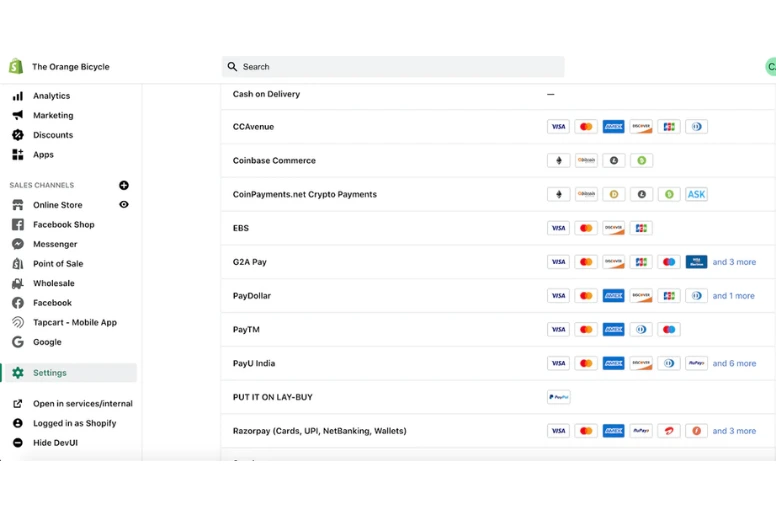
Shopify offers a variety of payment methods that merchants can use on their online stores:
- Shopify Payments: This is Shopify’s own payment system that lets merchants accept credit card payments directly on their website. It works with major credit cards like Visa, Mastercard, American Express, and Discover.
- PayPal: Shopify integrates with PayPal, which allows customers to make payments using their PayPal accounts. PayPal is a secure and well-known payment option.
- Stripe: Shopify also works with Stripe, a popular payment gateway. It lets customers pay with credit cards and supports different currencies.
- Apple Pay: Shopify supports Apple Pay, enabling customers to make purchases easily using their Apple devices with just a touch or click.
- Google Pay: Shopify integrates with Google Pay, allowing customers to make payments using their Google account information.
- Klarna: Klarna is a service that integrates with Shopify and offers a “buy now, pay later” option. Customers can make purchases and pay for them in installments over time.
- Amazon Pay: Similar to the Amazon Payment method mentioned earlier, Shopify also supports Amazon Pay as a payment option. Customers can use their Amazon account details to make purchases on Shopify.
Amazon
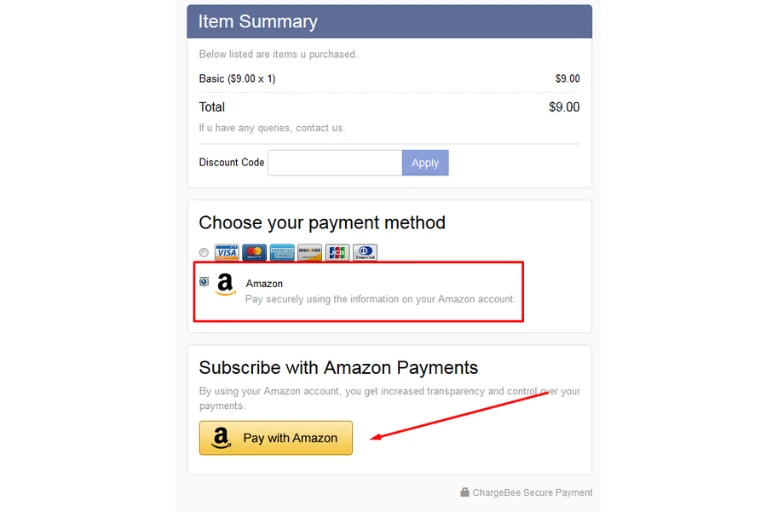
Next on Shopify vs Amazon comparison, let’s look at Amazon’s payment options, including:
- Credit or Debit Cards: Amazon accepts major credit and debit cards, such as Visa, Mastercard, American Express, and Discover, for payment on its platform.
- Amazon Store Card: This is a credit card issued by Synchrony Bank exclusively for Amazon customers. It provides special financing options and rewards specifically for purchases made on this online marketplace.
- Amazon Gift Cards: Customers can use Amazon gift cards to make purchases on the platform. These gift cards can be purchased online or in physical stores and can be used as a form of payment during checkout.
- Amazon Pay: Amazon Pay is a digital wallet service offered by Amazon. Customers can make payments using their Amazon account information on various websites and apps that accept Amazon Pay.
- Amazon Cash: Amazon Cash is a service that allows customers to add cash to their Amazon account. They can visit participating retailers and present a barcode to add cash, which can then be used for purchases on Amazon.
Which is better, Amazon or Shopify in terms of Payment methods? Shopify wins
When comparing Shopify vs Amazon, it’s clear to see that Shopify offers a broader range of payment options compared to Amazon.
7. Marketing features
Marketing is extremely important when it comes to selling online, whether on Amazon or Shopify. It helps you bring more people to your online store, boost your sales, and create a thriving business.
Shopify

In terms of SEO (Search Engine Optimization) plans, Shopify focuses on making your store visible on search engines like Google. With its customizable system and SEO-friendly features, Shopify lets you make product listings, metadata, and URLs that are optimized. This helps boost your store’s ranking in organic searches, bringing in more specific visitors.
But that’s not all – Shopify also provides a bunch of marketing tools. You get built-in email marketing features, ways to share content, promote on social media, use affiliate marketing, and more.
It’s worth noting that Shopify works well with Google and Facebook, making it easy to create ads for these platforms. And if you ever feel like you need more tools, you can add more marketing apps from the Shopify marketplace to make your marketing efforts even stronger.
Amazon
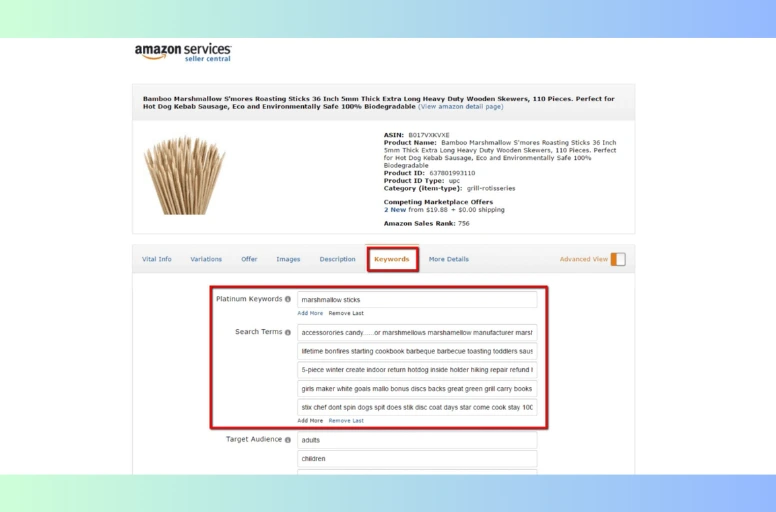
Unlike Shopify, Amazon’s plan for SEO is mainly about beating other sellers in its own search results, not so much about doing well on external search engines. If you sell on Amazon, you need to pay attention to things like how relevant your product is, what ratings and reviews it has, and how well you’re handling the fulfillment process. These factors will help push your product higher in Amazon’s search rankings.
Amazon also has quite a few marketing tools, mostly for advertising:
- Amazon DSP is a platform where you can purchase display, video, and audio ads, whether you want them on or off Amazon.
- Amazon Live enables you to broadcast live videos that are interactive and shoppable throughout Amazon.
- Amazon Ads provides different kinds of ads, both on the site and off the site.
A side note on the conversion rate of Shopify vs Amazon
Here is something you may take into serious consideration – the conversion rate. For so long, the conversion rate directly affects your sales and overall business operation. Also, it has a lot to do with your ongoing marketing efforts. Cutting the long short, we’ve got you some notes about conversion rates on Shopify vs Amazon.
- Shopify: It requires a lot more work to eventually convert a visitor into purchases. This also means you put a lot of effort into promoting your products. Not to mention, selling on Shopify can indicate you’ll be drawing traffic to your store all by yourself. So if you are a new individual seller, this place is probably not the best one, especially for someone who is after converting customers and raising sales volume.
- Amazon: The conversion rate on Amazon is likely to be higher. Keep in mind that Amazon is a long-trusted online marketplace. More than that, Amazon is almost Google for online shoppers. That’s why your chances to convert visitors into purchases may be higher. Yet, there is a string attached to this. You must run your store and always make sure your products appear on the first result page.
Which is better, Amazon or Shopify in terms of marketing features? It’s an equal match!
Both Shopify vs Amazon offer robust marketing tools, but if you aim to establish a personal brand, Shopify may be a better fit compared to Amazon.
8. Integrations and add-ons
The next part of our Shopify vs Amazon analysis concerns integrations and add-ons. From our viewpoint, both channels have extensive integrations.
Shopify
To be more specific, we’ll start with Shopify. The eCommerce platform is long reputed for its massive app store with 8000+ apps. In fact, Shopify gains its dominance among other eCommerce platforms thanks to this powerful third-party app market.
Going further into details, from page building and inventory management to referral programs and multichannel selling, Shopify has them all available on its app store for you.
If you have been familiar with Shopify for a while, you may have heard of some of the popular apps across this platform. They include:
- LitCommerce for multichannel selling
- ShipBob and ShipStation for shipping and order fulfillment
- Referral Candy and Affiliate for referral programs
- Dropified for dropshipping
- Transcy for translation and currency conversion
- BOGOS by Secomapp for discounts and promotions
LitCommerce is A Shopify Trusted Partner for Multi-selling
Proud to be a trusted partner with Shopify, LitCommerce devotes itself to helping merchants list, manage, and earn revenue not just on but beyond Shopify.
Amazon
It’s time we mention Amazon integrations and add-ons to prove that it is just as powerful as Shopify.
First, here are some fulfillment integrations:
- Amazon Multi-Channel Fulfillment (MCF): This allows you to leverage Amazon’s fulfillment network for orders from your own website or other marketplaces.
- Third-Party Fulfillment Integrations: Many third-party fulfillment services integrate seamlessly with Seller Central. Some popular integrations are ShipStation, Ordoro, and Regional 3PLs.
For inventory management integrations:
- Order Management Systems (OMS): These systems centralize order fulfillment from various channels, including Amazon. Popular options like Ordoro or Zoho Inventory integrate with Seller Central to automate tasks like order routing, inventory updates, and shipment tracking.
- Warehouse Management Systems (WMS): For sellers with larger inventories, a WMS can optimize warehouse operations and integrate with Seller Central for real-time inventory visibility.
For data and marketing integrations:
- Accounting software: Integrate your accounting software (like QuickBooks) with Seller Central to automate tasks like bookkeeping and tax calculations based on your Amazon sales data.
- Marketing and advertising tools: Connect Seller Central with marketing platforms like Facebook Ads to leverage customer data for targeted advertising campaigns. There are also built-in advertising platforms like Amazon DSP (Amazon Demand-side Platform).
Notes: For advanced sellers with developer resources, Amazon Seller Central offers a suite of APIs (Application Programming Interfaces) that allow for custom integrations. This enables building functionalities specific to your business needs.
Shopify vs Amazon integrations and add-ons, which won? It’s an equal match!
We believe both sales channels have done a great job with integrations and add-ons. However, Amazon integrations and add-ons are not as powerful as Shopify’s regarding designing and store customization. This could result from Shopify’s being an eCommerce platform, providing any seller with greater capabilities in this area.
Yet, when we consider aspects such as store management, warehouse mapping, and inventory control, Amazon and Shopify can be considered equal matches.
Integrate Shopify with Amazon – Why not?
You can easily integrate Shopify with Amazon and leverage the power of both channels in 4 steps with LitCommerce: Connect – List – Sync – Manage
Amazon vs Shopify: FAQs
As mentioned earlier, there are fundamental philosophical differences between Shopify vs Amazon. Shopify is a specialized eCommerce platform, while Amazon operates as an online marketplace. While Shopify has lower annual costs and fewer fees, the built-in customer base provided by Amazon makes the decision ultimately dependent on your business model. If you are ready to invest effort in marketing, Shopify is likely the better choice. Shopify vs Amazon do compete to some extent, but they cater to different segments of the eCommerce market. Amazon is a vast online marketplace where sellers can list their products and access a wide customer base. On the other hand, Shopify is an eCommerce platform enabling businesses to establish their individual online stores. While there is competition, many businesses leverage both Amazon and Shopify in complementary ways. For instance, some use Amazon to reach a larger audience and utilize Shopify to independently build and establish their brand. The choice between Shopify vs Amazon may depend on your business goals. If building and promoting your own brand is a priority, Shopify is the ideal destination. However, if you are looking for a simpler way to list your products, Amazon would be your optimal choice. Certainly! Numerous Shopify store owners utilize Shopify apps like LitCommerce to synchronize inventory and sell products from their stores on Amazon. This approach eliminates the need for separate selling plans and allows for centralized inventory management. In terms of integration, Amazon does accept Shopify. You can integrate Amazon with Shopify right from the Shopify dashboard or use a third-party integration tool. Speaking of which, consider LitCommerce – your All-in-one Shopify Amazon integrator. Some sellers may use Shopify instead of Amazon because of the advanced store customization, marketing tools, and other eCommerce tools. It can also refer to Amazon’s competitiveness. However, Amazon would still be a great place for any seller if they target a massive traffic source of 2+ billion per month (according to SimilarWeb) From our perspective, you should consider the pros and cons of each platform to decide if Shopify or Amazon is the best for dropshipping. The advantages of Shopify for dropshipping are: Amazon’s advantages for dropshipping: From this, we suggest the best approach may be to use both platforms. The right mix of Shopify and Amazon can create a powerful multichannel dropshipping strategy.
Shopify vs Amazon Store: Which is Your Best Choice?
In summary, both Shopify and Amazon are dominant players in their respective sectors. Ultimately, personal preference plays a significant role in the decision-making process. However, there’s no strict need to choose between Shopify and Amazon exclusively. You can enjoy the benefits of both platforms by utilizing Shopify Amazon integration.
We hope that this comparison between Shopify vs Amazon has provided the information you were looking for and has assisted in your decision-making process. Finally, don’t forget to explore our blog for additional eCommerce tips and news. If you have any questions, feel free to reach out to us!




